To start, let’s look at one of the most recognizable and yet sometimes neglected parts of a bike, and one of my favourite subjects too. The world of tyres. Before we dive in, a little history…
Almost from the beginning of the invention of the wheel, there have been tyres. These early efforts were made at first from hard woods in medieval times, graduating to iron after the industrial revolution, and solid rubber thereafter. Their sole job was to prevent wooden wheels from destroying themselves on the incredibly rough roads of the day.
To find the true forerunner of today’s design (A rubber and canvas carcass over an air chamber) we consider the design of John Boyd Dunlop. A Scottish veterinarian with a keen interest in bicycle racing, his pneumatic tyre design of 1888 really set the stage for everything we ride on today.
Meanwhile in Germany, another historic milestone took place , also that same year. 1888.
Karl Benz, an engineer and inventor had come up with a vehicle that ran on an internal combustion engine. Historians will tell you this was the first car, but in truth it was far more like a very rudimentary trike or Can Am Spyder This was actually a pretty big deal because up to that point, the only way of getting forward motion was either by horse, or a steam locomotive. There was a problem however. Nobody was even slightly interested in it, causing a great deal of frustration and depression for poor old Karl.
This is where it gets interesting. Karl’s wife Bertha presumably had enough of her husband’s moping, and with her teenage sons stole the trike and drove it half-way across Germany to visit her sister. Suddenly people took notice of this new form of transportation and the rest as they say, is history. Would Bertha Benz be signing up for WRWR if she were alive today? I like to think so.
Anyway I digress, back to tyres.
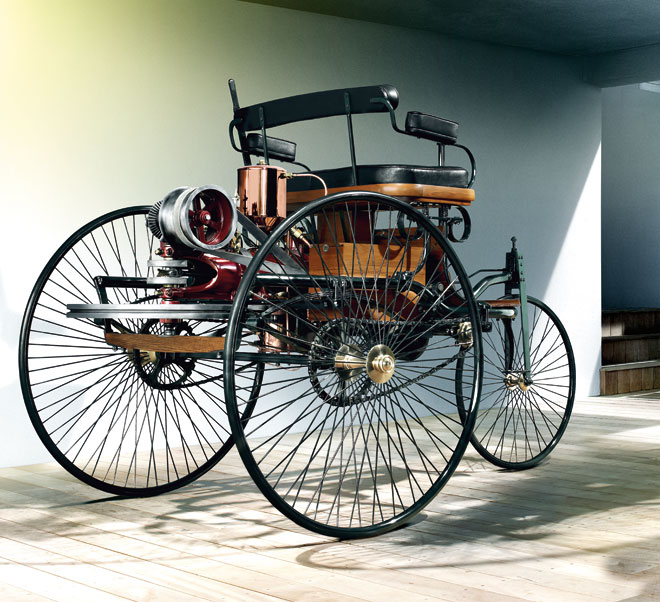
The Basics
Your tyres. They’re black n’ round and there’s two of ’em. Anything else? Actually there’s a wealth of information right there on the sidewalls of your tyre, but some of it’s in code. Here’s how to read it.
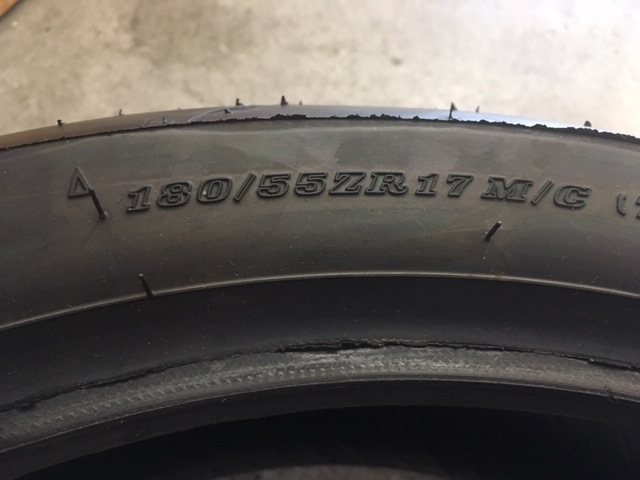
Here’s a tyre I pulled off a Kawasaki 900 this morning. The tyre size is shown as 180/55 ZR17 M/C. A typical sport bike size. This numerical system can be a little confusing at first because it’s both in millimeters AND inches. Lets break it down.
180 is the width of the tyre in millimeters. This is not an exact figure. Manufacturers have some leeway when it comes to sizing. Avons can run big, Contis are often small. Either way it should be within 5mm of the given figure. To give you some idea of the range of sizing, a cruiser or dirt bike could have a 90 up front. Conversely, the new Ducati Panigale has a 200 rear tyre. Some heavyweight cruisers can go even larger than that. All the bike makers and tyre makers have a recommended size for a particular bike.
55 is the aspect ratio. Basically, it’s the percentage of the tyres height in relation to it’s width. In this case, 55% of 180mm. The tyre is 99mm high from the edge of the rim to the tip of the tread. Generally speaking, the lower this number, the sportier the application. 55 is a very sporty tyre. A tyre with 60 or 70 as the aspect ratio is still considered sports oriented. A cruiser would have a 80 or 90 ratio. A common size here would be 130/90-. Almost all vintage bikes are 90. A typical application on a vintage Triumph or Norton would be 100/90- .
ZR refers to the speed rating of the tyre. There are a ton of these, and I’m not going to bore you with all of them , but some common ones are :- S up to 112 M.P.H. (180 km/h) , H up to 130 M.P.H. (210 km/h), and Z over 168 M.P.H. (270 km/h). Hang on you say, I never ride my bike that fast, why pay for high speed rating tyres. If your bike calls for H or V rated tyres, stick with them. They are made to handle the power and braking forces a sports bike can exert.
17 refers to the diameter of the wheel in inches. This wheel is 17 inches across. A very common size. If you have a cruiser or dirt bike expect a 21 inch or 19 inch wheel up front. A cruiser can have a 16 or 15 inch wheel out back, many older bikes have 18inch rear wheels.
M/C is just an abbreviation for Motorcycle. Unlikely to find car tyres in this size, but it’s not impossible to find some specialist sidecar or trike only applications.Put either of these on a two wheel application and the cornering would be not good to say the least!
To the left of the picture, there is a small arrow pointing upward. All tyres have these, sometimes accompanied by the letters TWI. This is a molded ridge that runs across the tread and shows when the tyre is due for replacement . TWI = Tread Wear Indicator.
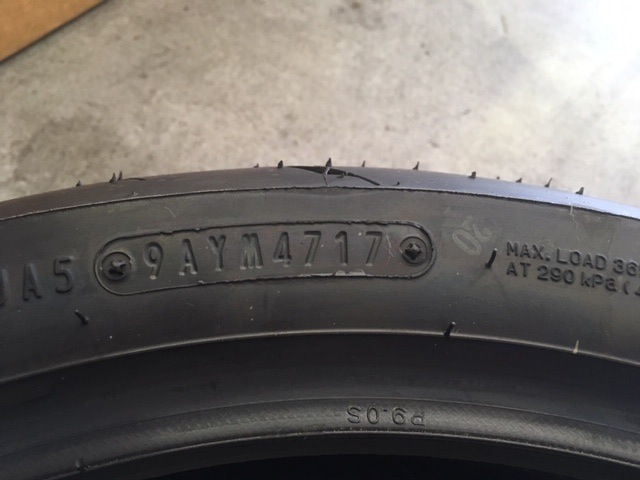
This final picture has a lot of information to absorb. On the right of the shot, you see a maximum load at a given pressure. I deliberately left off the figures because they are all different. Of note here is the max pressure. This is NOT the correct tire pressure for your bike. It is an absolute maximum pressure presuming the bike has been loaded to it’s absolute limit in weight for that tyre. For your correct pressure refer to the owner’s handbook or there is usually a sticker on the chain guard or rear suspension giving the correct figures. If both are missing, a good starting point is 36 p.s.i front and 42 p.s.i. rear for sport bikes. For cruisers, 33 front and 36 rear is a great place to start.
Toward the centre of the picture there is a molded panel with 9AYM4717. The first for digits are the serial number of the tire and the manufacturing plant. The last four are the ones of interest. This is when your tyre was made. 47 is the week and 17 the year. 47th week of 2017. This tyre is not yet one year old. Why is this important? As a rule, tyres will start to deteriorate at five years old. Don’t panic just yet, depending on the climate and use, you still may be good up to 10 years old. After that, even if they have loads of tread, it’s far too dangerous to keep riding on them. Hunt this panel out on your tires, they may be older than you think.
In the coming section, we will explore some common tyre problems and how to care for them.
Common Motorcycle Tyre Problems
Now we’ve explored the information contained within your tyres codes, let’s look at a few common problems and what should be done about them.
Cupping

This can be a very common problem on sport bike tyres in particular. As you can see, the tread on the outer edge has worn in such a way as to form sharp edges on one side of the pattern. The less common name for this is “scalloping” which describes the shape perfectly.
A variety of factors can cause this, including incorrect tyre pressure, badly aligned forks, poor suspension condition, or just the tyre construction itself. Even though it looks alarming, the general rule is :- if you can hear it “hum” when you corner, it’s okay. If you can both hear AND feel it vibrate, it’s time for a new tyre.
Uneven Tread Wear
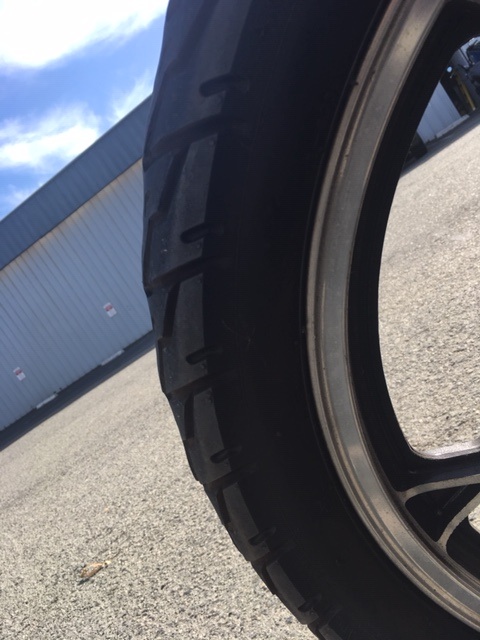
This is a less common problem, but I guarantee that if there are any large number of bikes parked, you will see at least a couple of tyes like this. It’s very important to recognize the difference in wear between this and the previous scalloped tyre.
Here, the tread forms an symmetrical “hump” and is formed over the centre section and not the sides, although they can be affected too, just less so.
The culprit here is chronically low tyre pressure. Because the tyre was not fully inflated, the weight of the bike (in this case a Suzuki GSX1100) has caused the tread pattern to deform and wear in this peculiar way.
Even correctly balanced, this tyre will give an extremely rough ride at any speed.
Replacement is the only safe solution.
Dry Checking
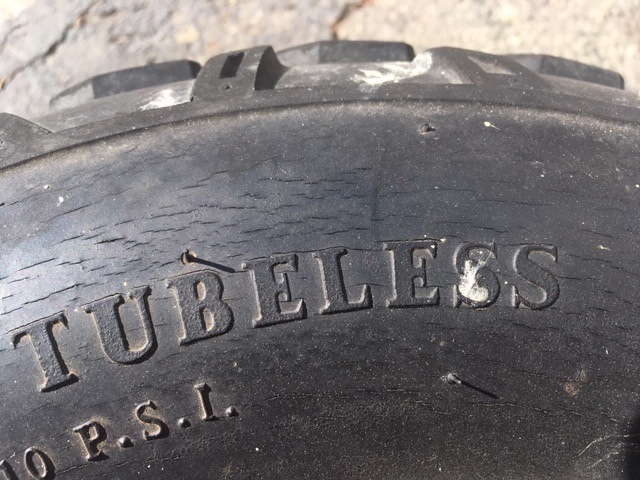
Here’s an ATV tyre I pulled from the scrap pile this morning. Because the sidewall is smooth and covers a large area , it’s easy to see the tiny cracks appearing.
Yours may not be so visible because of the pattern on your tyre. The culprit here are really two culprits. Time and the sun.
If you are in a warm, sunny climate, especially if your tyres are in that five- to- ten year range, you will see this.
When each crack becomes longer than half an inch (14mm) or begins to open up like a mouth (look carefully above the”U”) then scrap the tyre.
Again, if in doubt, always replace.
Nail In Tread
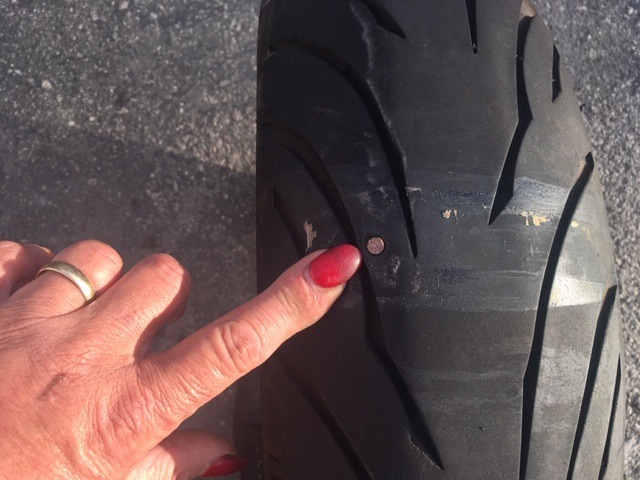
Sooner or later, you’re going to get a puncture. It’s a way of life for anyone whose spent time on a bike, some are quick and scary, others a slow deflation. For those with spoked wheels, removing the object and fitting a new tube will get you rolling again. Before we go any further, I know that some adventure-bike makers have been utilizing tubeless technology for spoked wheel for a while now, but as a rule – Spoke or wire wheels means an inner tube. Your tyre may say “tubeless” on the sidewall, but it has a tube within. The disadvantage here is that the fix-a-flat aerosol can, available in many countries, will NOT work with a tube application.
Cast aluminum wheels allow the use of tubeless tyres which is what the industry normal seems to be today. What happens if I get a puncture? Here’s a tyre I pulled from a Suzuki Bandit. This would be a good candidate for repair. The nail is fairly small, and the impact is within the centre section of the tread. Any further to the edge, a repair would not work because this is an area of high stress and flex where the integrity of the tyre construction is vital for safety.
To repair this tyre, use a plug you can push through from the outside and a can of fix-a-flat will get you home, but you should stay under 50 m.p.h. (80 k.m.h) and consider this a TEMPORARY fix. For a permanent repair, you should use a plug patch which seals the hole itself and a large contact area within the tyre.
Again, if in doubt, always replace.
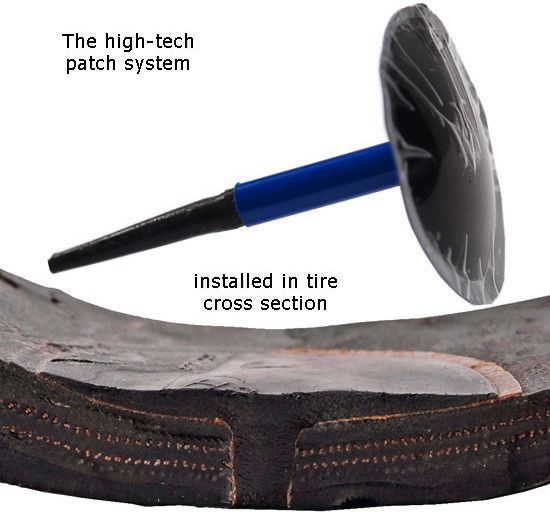
Caring for your tyres
Tyres are an expensive part of our bikes. When properly cared for, we can get the maximum mileage and value from them . Top quality care is actually very easy.
Check your pressures often.
How often? I know there are some commercial drivers among us who perform a pre-trip inspection on their truck or bus every time it leaves home base. This really isn’t practical for every quick ride, but everytime you fill up with fuel, it’s an ideal time to quickly check the pressures. I am often asked which gauge is best, and I usually answer ” the one you can carry with you and use”. I like the pen-type gauge because it fits easily in my pocket or purse and it has an old-fashioned analog feel to it. Many prefer the dial gauge, easier to read, but a little bulkier to carry. Either way, check those pressures as often as you can.
When you clean your bike, avoid using harsh chemicals around the tyres as they can dry out the natural oils within the rubber and cause premature dry checking.
Also avoid that stuff that gives tires a shine or “wet-look” . It works great on plastic trim pieces, but keep it away from rubber. The best way to make your tyres look new is to use very mild soapy water and a scrubbing brush.
If your bike has whitewalls or white letters, you can keep them looking bright with toothpaste. Really! (An ancient hot-rodder told me that trick)
Above all else BE SAFE and happy riding…
